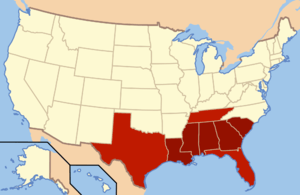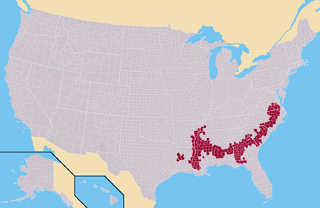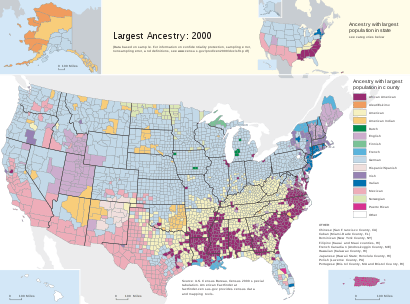Deep South

The Deep South is a cultural and geographic subregion in the Southern United States. Historically, it is differentiated from the "Upper South" as being the states most dependent on plantation-type agriculture and considered slave societies during the pre–Civil War period. The Deep South was also commonly referred to as the Lower South or the Cotton States, for their production of cotton as the primary commodity crop.[1][2]
Before the out-migrations from the Deep South during the first half of the 20th century, African-descended peoples, whose ancestry also often included the British Isles, comprised the majority of the population in numerous counties and some states. Today, the Deep South is usually delineated as being those states and areas where the cultural elements most often thought of as "Southern" exist in their most concentrated form.[3]
Usage

The term "Deep South" is defined in a variety of ways:
- Most definitions include the states Georgia, Alabama, South Carolina, Mississippi, and Louisiana.[4]
- The seven states that seceded from the United States before the firing on Fort Sumter and the start of the American Civil War, and were the first to form the Confederate States of America. Ultimately the Confederacy included eleven states. In order of secession they are: South Carolina, Mississippi, Florida, Alabama, Georgia, Louisiana, and Texas. The first six states to secede were those that held the largest number of slaves.
- A large part of the original "Cotton Belt". This was considered to extend from eastern North Carolina to South Carolina and through the Gulf States as far west as East Texas, and including those parts of western Tennessee and eastern Arkansas in the Mississippi embayment.[3] Some of this is coterminous with the Black Belt, originally referring to upland areas of Alabama and Mississippi with fertile soil, which were developed for cotton under slave labor. The term came to be used for much of the Cotton Belt, which had a high percentage of African-American slave labor.
Origins
Though often used in history books to refer to the seven states that originally formed the Confederacy, the term "Deep South" did not come into general usage until long after the Civil War ended. Up until that time, "Lower South" was the primary designation for those states. When "Deep South" first began to gain mainstream currency in print in the middle of the 20th century, it applied to the states and areas of Georgia, southern Alabama, Florida, Mississippi, north Louisiana, and East Texas, all historic areas of cotton plantations and slavery. This was the part of the South many considered the "most Southern".[8]
Later, the general definition expanded to include all of South Carolina, Georgia, Alabama, Mississippi, and Louisiana, and often taking in bordering areas of East Texas and North Florida. In its broadest application today, the Deep South is considered to be "an area roughly coextensive with the old cotton belt from eastern North Carolina through South Carolina west into East Texas, with extensions north and south along the Mississippi".[3] Houston is the largest city of the Deep South region.[9][10][11]
People

European Americans or whites in every part of the Deep South except for southern Louisiana have often identified as having predominately English ancestry, but numerous Irish and Scots-Irish immigrants and migrants also entered the region, especially in the upcountry outside the plantation areas. They sometimes served as overseers on plantations. In the 1980 census, of those people who identified solely by one European national ancestry, more European Americans identified as of English ancestry in every Southern state except Louisiana, where more people identified as having French ancestry.[12]
With regards to people in the Deep South who reported only a single European-American ancestry group in 1980, the census showed the following self-identification in each state in this region:
- Alabama - 857,864 persons out of a total of 2,165,653 people in the state identified as "English," making them 41% of the state and the largest national ancestry group at the time by a wide margin.
- Georgia - 1,132,184 out of 3,009,484 people identified as "English," making them 37.62% of the state's total.
- Mississippi - 496,481 people out of 1,551,364 people identified as "English," making them 32.00% of the total, the largest national group by a wide margin.
- Florida - 1,132,033 people out of 5,159,967 identified "English" as their only ancestry group, making them 21.94% of the total.
- Louisiana - 440,558 people out of 2,319,259 people identified only as "English," making them 19.00% of the total people and the second-largest ancestry group in the state at the time. Those who wrote only "French" were 480,711 people out of 2,319,259 people, or 20.73% of the total state population.
- Texas - 1,639,322 people identified as "English" only out of a total of 7,859,393 people, making them 20.86% of the total people in the state and the largest ancestry group by a large margin.
These figures to do not take into account people who identified as "English" and another ancestry group. When the two were added together, people who self identified as being of English with other ancestry, made up an even larger portion of southerners.[13] South Carolina was settled earlier than those states commonly classified as the Deep South. Its population in 1980 included 578,338 people out of 1,706,966 people in the state who identified as "English" only, making them 33.88% of the total population, the largest national ancestry group by a large margin.
The map to the right was prepared by the Census Bureau from the 2000 census; it shows the predominant ancestry in each county as self-identified by residents themselves. Note: The Census said that areas with the largest "American"-identified ancestry populations were mostly settled by descendants of colonial English and others from the British Isles, French, Germans and later Italians. Those who are African-descended tended to identify as African American, although many of historically mixed-race families also have ancestors of British Isles or Northern European ancestry.
As of 2003, the majority of African-descended Americans in the South live in the Black Belt counties.[14]
Politics
From 1880 to the early 1960s, conservative whites of the Deep South regained control of state governments and overwhelmingly identified as and supported the Democratic Party (most had belonged to it before the Civil War). Many belonged to the party's moderate-to-conservative wing. At the same time, numerous Republicans, primarily African Americans, continued to be elected in local offices through the 1880s and into the 1890s. At the end of the century, Republicans and Populists briefly elected governors in some states, as well as other fusion candidates. The Republicans elected an African-American congressman in 1894, before most of the states had passed new constitutions or other laws disenfranchising most blacks from the turn of the century.
At the turn of the 20th century, all of the Southern states, starting with Mississippi in 1890, passed new constitutions and other laws that effectively disenfranchised millions of blacks and many poor whites to prevent populist coalitions, and excluded them from the political system entirely. Generally they created barriers to voter registration and sometimes to voting itself. The white Democratic-dominated state legislatures passed laws to impose white supremacy and Jim Crow, including racial segregation of public facilities.[15] The region became known in politics as "Solid South" for decades: while this disenfranchisement was enforced, all of the states in this region were one-party states dominated by white Southern Democrats. Its representatives accrued outsized power in the Congress and the national Democratic Party, as they controlled all the seats apportioned to southern states based on total population but represented only white voters.[16] During this same period, the number of lynchings of blacks by whites reached a peak in the region; the most deaths annually were in the years shortly before the turn of the century, when economic problems and stress were high in the region.
Major demographic changes ensued in the 20th century; during the two waves of the Great Migration, a total of 6 million African Americans left the South for opportunities in the North, Midwest and West Coast. In some areas, white migration increased into the South, especially since the late 20th century. Beginning with the Goldwater–Johnson election of 1964, a significant contingent of white conservative voters in the Deep South stopped supporting national Democratic Party candidates and switched to Republicans. They still voted for many Democrats at the state and local level into the 1990s.
The Republican Party in the South had been crippled by the disenfranchisement of blacks, and the national party was unable to relieve their injustices in the South. During the Great Depression and the administration of Democrat Franklin D. Roosevelt, some New Deal measures aided African Americans across the country and in the poor rural South, as well as poor whites. In the post-World War II era, some Democratic Party presidents and national politicians began to support desegregation and other elements of the African-American Civil Rights Movement, from President Harry S. Truman's desegregating the military, to John F. Kennedy's support for non-violent protests. These efforts culminated in Lyndon B. Johnson's important work in gaining Congressional approval for the Civil Rights Act of 1964 and Voting Rights Act of 1965. Since that period, many African Americans in the South and the rest of the nation have supported the Democratic Party as supportive of civil rights.
White southern voters consistently voted for the Democratic Party for many years, in order to hold onto Jim Crow Laws. "The weird thing about Jim Crow politics is that white southerners with conservative views on taxes, moral values, and national security would vote for Democratic presidential candidates who didn't share their views. They did that as part of a strategy for maintaining white supremacy in the South." (Yglesias 2007).[17] When the leaders of the Democratic party started to leave office, they were replaced with people who did not share the views of their voters.
One opinion piece attributed the political and cultural changes, along with the easing of racial tensions, as the reason why southern voters began to vote for Republican national candidates, in line with their political ideology.[18] Since then, white Southern voters have voted for Republican candidates in every presidential election except in the 1976 election when Georgia native Jimmy Carter received the Democratic nomination, the 1980 election when Carter won Georgia, the 1992 election when Arkansas native and former governor Bill Clinton won both Georgia and Louisiana, and the 1996 election when the incumbent president Clinton again won Louisiana. In 1995, Georgia Republican Newt Gingrich was elected by representatives of a Republican-dominated House as Speaker of the House.
Since the 1990s the white majority has continued to shift toward Republican candidates at the state and local levels. This trend culminated in 2014, when the Republicans swept every statewide office in the region midterm elections. As a result, the Republican party came to control all the state legislatures in the region, as well as all House seats that were not representing majority-minority districts.[19]
Continuing demographic changes are likely to influence regional politics: many educated African Americans are migrating back to the South, and taking professional and middle-class jobs; there have been waves of immigration from Latino countries of Mexico, and Central and South America; and white northerners have also moved to the South for jobs or to retire.
Presidential elections in which the Deep South diverged noticeably from the Upper South occurred in 1928, 1948, 1964, 1968, and, to a lesser extent, in 1952, 1956, 1992, and 2008. Former Arkansas Governor Mike Huckabee fared well in the Deep South in 2008 Republican primaries, losing only one state (South Carolina) while running (he had dropped out of the race before the Mississippi primary).[20]
See also
References
- ↑ Fryer, Darcy. "The Origins of the Lower South". Lehigh University. Retrieved 30 December 2008.
- ↑ Freehling, William (1994). "The Editorial Revolution, Virginia, and the Coming of the Civil War: A Review Essay". The Regeneration of American History. New York: Oxford University Press. p. 10. ISBN 978-0-19-508808-3. Retrieved 2008-12-30.
- 1 2 3 John Reed and Dale Volberg Reed, 1001 Things Everyone Should Know About the South, Doubleday, 1996
- ↑ "Deep South". The Free Dictionary. Retrieved 2007-01-18.
- ↑ Neal R. Pierce, The Deep South States of America: People, Politics, and Power in the Seven States of the Deep South (1974), pp 123-61
- ↑ Williard B. Gatewood Jr. and Jeannie M. Whayne, eds. (1996). The Arkansas Delta: Land of Paradox. University of Arkansas Press. p. 3.
- ↑ Diane D. Blair; Jay Barth (2005). Arkansas Politics and Government. U of Nebraska Press. p. 66.
- ↑ The Encyclopedia of Southern History. Edited by David C. Roller and Robert W. Twyman. Baton Rouge: Louisiana State University Press, 1979
- ↑ Moskin, Julie (2004-06-18). "An Obscure Texas Celebration Makes Its Way Across the U.S.". The New York Times. Retrieved 2011-04-28.
- ↑ "The World Celebrates Freedom". Juneteenth.com. Retrieved 2006-06-19.
- ↑ "Census Bureau Regions and Divisions with State FIPS Codes" (PDF). US Census. December 2008. Retrieved December 24, 2014.
- ↑ 1980 U.S. census
- ↑
- ↑ Frank D. Bean, Gillian Stevens. America's Newcomers and the Dynamics of Diversity. p. 213. doi:10.7758/9781610440356. ISBN 9781610440356. JSTOR 10.7758/9781610440356.
- ↑ Gabriel J. Chin & Randy Wagner, "The Tyranny of the Minority: Jim Crow and the Counter-Majoritarian Difficulty,"43 Harvard Civil Rights-Civil Liberties Law Review 65 (2008)
- ↑ Richard M. Valelly, The Two Reconstructions: The Struggle for Black Enfranchisement University of Chicago Press, 2009, pp. 146-147
- ↑ Yglesias, "Why did the South turn Republican?", The Atlantic
- ↑ Opinion: "It's Not Dixie's Fault", Washington Post, 17 July 2015
- ↑ "Demise of the Southern Democrat is Now Nearly Complete". The Sydney Morning Herald. 12 December 2007. Retrieved 2007-12-13.
- ↑ Charles S. Bullock III and Mark J. Rozell, eds. The New Politics of the Old South: An Introduction to Southern Politics (2009)
Further reading
- Brown, D. Clayton. King Cotton: A Cultural, Political, and Economic History since 1945 (University Press of Mississippi, 2011) 440 pp. ISBN 978-1-60473-798-1
- Davis, Allison. Deep South: A Social Anthropological Study of Caste and Class (1941) classic case study from the late 1930s
- Dollard, John. Caste and Class in a Southern Town (1941), a classic case study
- Harris, J. William. Deep Souths: Delta, Piedmont, and Sea Island Society in the Age of Segregation (2003)
- Key, V.O. Southern Politics in State and Nation (1951) classic political analysis, state by state
- Pierce, Neal R. The Deep South States of America: People, Politics, and Power in the Seven States of the Deep South (1974) in-depth study of politics and issues, state by state
- Rothman, Adam. Slave Country: American Expansion and the Origins of the Deep South (2007)